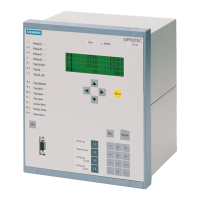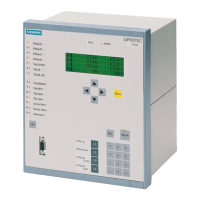Introduction
1.1 Overall Operation
SIPROTEC, 7UM62, Manual
C53000-G1176-C149-7, Release date 03.2010
23
The device has 8 current and 4 voltage inputs. Three current inputs are used on each side of the protected
object for measuring of the phase currents. 2 current inputs are equipped with sensitive input transformers (I
EE
)
and can measure secondary currents in the mA range. 3 voltage inputs acquire the phase-to-earth voltages
(connection to phase-to-phase voltages and voltage transformers in V connection is possible as well). The 4th
voltage input is for the displacement voltage measurement for the stator and rotor earth fault protection.
The IA input amplifier group allows high impedance connection for analog input values and contains filters op-
timized for measured value processing bandwidth and speed.
The AD analog digital converter group contains high-resolution ΣΔ digital converters (22 bits) and memory com-
ponents for data transfer to the microcomputer.
Micro Computer System
The implemented software is processed in the microcomputer system (µC). Major functions are:
• Filtering and conditioning of the measured signals,
• Continuous monitoring of the measured quantities,
• Monitoring of the pickup conditions for the individual protection functions,
• Querying of limit values and time sequences,
• Controlling signals for logic functions,
• Decision for trip commands,
• Signalling of protective actions via LEDs, LCD, relays or serial interfaces,
• Recording of messages, fault data and fault values for fault analyis,
• Management of the operating system and the associated functions such as data recording, real-time clock,
communication, interfaces, etc.
Adaptation of Sampling Frequency
In order for the protection and measurement functions to produce correct results over a wide frequency range,
the actual frequency is continuously measured and used for adjusting the sampling frequency for the mea-
sured value processing. This ensures measuring accuracy in the frequency range from 11 Hz to 69 Hz.
The sampling frequency adjustment can, however, operate only when at least one a.c. measured quantity is
present at one of the analog inputs, with an amplitude of at least 5 % of rated value („operational condition 1“).
If no suitable measured values are present, or if the frequency is below 11 Hz or above 70 Hz, the device op-
erates in „operational condition 0“.
Binary Inputs and Outputs
Binary inputs and outputs from and to the computer system are routed via the I/O modules (inputs and outputs).
The computer system obtains the information from the system (e.g remote resetting) or the external equipment
(e.g. blocking commands). Outputs are mainly commands that are issued to the switching devices and mes-
sages for remote signalling of events and states.

